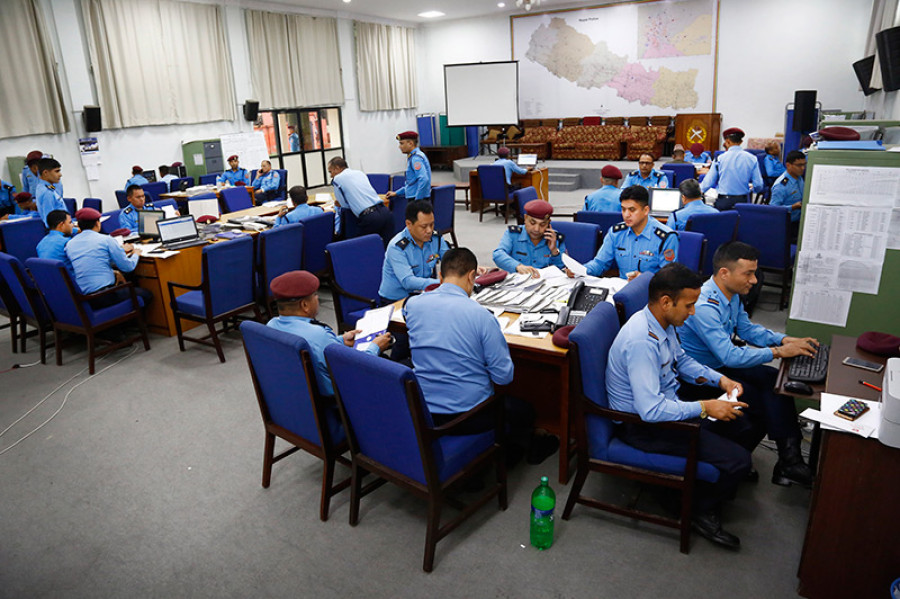Miscellaneous
Nerve Centre
In a spacious room in one of the many buildings inside the Nepal Police Headquarters, tables have been arranged to form a rectangle at the very centre.
Manish Gautam
In a spacious room in one of the many buildings inside the Nepal Police Headquarters, tables have been arranged to form a rectangle at the very centre. Flanking it are six desks manned by sprucely dressed police personnel, sifting through paperwork. These six desks each represent one of the country’s five regions, and one is dedicated for the Kathmandu Valley—each desk has a white dry erase board covered with numbers detailing the police and temporary police personnel deployed across the country and other vital information regarding arms and ammunition. Often, the crackle of a radio or a sudden cellphone ringtone pierces through the busy activity the room is immersed in. Reports from the ground are now flowing in thick and fast as the country gears up for the first phase of the local elections.
This is the central command for the Election Security Cell of the Nepal Police that will remain buzzing with activity for the next month until the two-phased elections conclude. As millions of voters turn up to vote in their local representatives for the first time in two decades, it is from this room that security arrangements across the country will be coordinated and managed.
On Tuesday night, when a clash erupted in Jugu of Gaurishankar Village Council-2 in Dolakha district between the supporters of the UML and CPN (Maoist Centre), a UML activist died and another was critically injured. Through that night, personnel stationed at the election cell gathered ground reports in order to grasp the gravity of the situation. The report that was handed to the Inspector General’s Office in the morning then formed the basis of the deployment of a team of investigators, led by a Senior Superintendent of the Police, from the Zonal office.

Following this overnight report, meetings were held at the Election Commission with security chiefs and Ministry of Home Affairs. It was then decided to heighten security in all the 34 districts where the first phase of the elections will be held on Sunday.
“This is a systematic effort we have adopted in order to streamline the flow of information that will allow us to take actions accordingly. Also, this is a one-door policy so that information and reports do not get scattered,” Inspector General of Nepal Police Prakash Aryal said.
Each regional and metropolitan desk inside the election cell collects data and then passes it on to senior officials seated at the desks in the middle. These officials then review and verify data before passing it on to police chief. When reports are unclear or inconclusive, the central command centre conducts video conferences—done through Nepal Police’s intranet network—with officers deployed on the ground. Each day, the regional desk collects a plethora of information including total arrests made, total clashes, and total deployment of police personnel. This information is in turn used to identify security gaps and works towards filling the voids. The command centre has recently also completed the GIS (Geographic Information System) mapping of each police official deployed in polling centres, along with their phone numbers and unique codes to efficiently communicate with them.
This information also makes its way to the Ministry of Home Affairs and the integrated security cell based inside the MoHA office in Singha Durbar, the bureaucratic hub of the government.

Nepal Police, which forms the core inner circle for election security, has always played a big role during elections. They guard the ballot boxes and ballot papers and provide assistance to voters while working closely with the chief election officers stationed at a polling station. The Nepal Police, this year, will be assisted by temporary police personnel, who by and large, will help manage the lines at a voting centre. A team of 15 personnel and an official of the Armed Police Force—also called the striking team—will also be present at voting centres and will provide cover for the Nepal Police. Personnel from the Nepal Army will form the outer ring of the security provisions arranged in a concentric circle.
Further, in view of ensuring that the elections are conducted without incident, the Nepal Police, in coordination with the Election Commission, has already concluded a sensitivity analysis of each of the districts going into the first phase of elections. This was done through information collected by the central command centre and other intelligence reports, and sought to analyse each polling station and centre. For the 34 districts holding election on Sunday, the MoHA has identified 3,000 polling stations as sensitive.
Based on the sensitivity analysis, the nerve centre will decide the number of security personnel deployed at each polling station. According to the security plan, each polling centres will have a team of five Nepal Police personnel—led by either an Inspector or a Deputy Superintendent of Police—and six temporary police personnel. But with the security situation fluid, the numbers will remain subject to change based on the daily security analysis done each day.
“After thorough analysis the Nepal Police, along with other security bodies, are now ready for the two phases of the local level election,” said Bal Krishna Panthee, spokesperson of the MoHA, “We are committed to ensuring that no untoward incident takes place as the citizens gear up to vote for their local representative.”




 12.12°C Kathmandu
12.12°C Kathmandu










